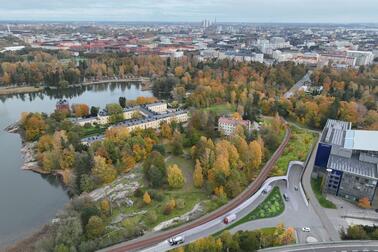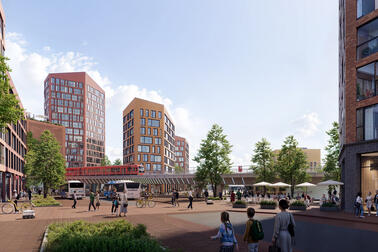
Advances in the protection of endangered animals
The aim of the City of Helsinki and the Port of Helsinki is to keep the environmental impact of the tunnel as low as possible and to minimise the need to cut down trees. Special construction techniques will be used to dig the tunnel, which enables a shorter-than-planned open pit. In this case, the trees in the key flying squirrel habitat on the west side of the tunnel entrance in Lapinlahti will be spared. The construction work will be scheduled in a way to allow the protected flying squirrels to nest in peace during the construction work.

Construction of the tunnel can only begin after the population of endangered depressaria chaerophylli moths has been successfully moved to a new location. This moth feeds on the rare turnip-rooted chervil. The search for a new location for these plants, which need to be moved for the construction, is underway. There are attempts to grow new plants from seedlings as well as by planting seeds. Testing for both methods is underway and their success is being monitored. The intention is to increase the amount of turnip-rooted chervil in the Lapinlahti area.


Reservation in the city plan for the West Baana
An area has been reserved in the detailed plan for the West Baana, which will travel from the inner city to Espoo. It is a significant part of the network of cycle paths that is under construction. The West Baana will be see detailed planning at a later stage, but the relevant policies for the Harbour Tunnel are being made now. The construction of the cycle path is scheduled for the beginning of the 2030s. The placement of the cycle path aims to utilise the area used for the tunnel construction.
Makasiiniranta for residents, smoother flow of traffic in southern Helsinki
The tunnel will free Makasiiniranta for the use of residents of especially for Jätkäsaari and Ruoholahti, but also the wider South Helsinki. A museum of architecture, office buildings and a shore path are planned for Makasiiniranta, which is currently used by the port.
In the future, ferry traffic to Stockholm will depart from Katajanokka and the ferry traffic to Tallinn will depart from the West Harbour. The tunnel improves vehicle access to the West Harbour and reduces all harbour-related traffic in the city centre by about 75%, as there are considerably more passenger cars and lorries on the Tallinn ferries than on the Stockholm ferries. The tunnel is intended for port traffic only, as it will end in the port area.
The Urban Environment Committee will discuss the detailed plan proposal in early 2025
The planning of the port tunnel began in 2022. After that, a general plan for the tunnel has been completed, the impact assessment of which was completed in spring 2024. An option with an entrance between the Lapinlahti park and the Ilmarinen building was chosen as the basis of the detailed plan.
The participation and evaluation plan of the detailed plan has been updated, as the planning area now includes only the alignment that ends at the southern edge of Lapinlahti. The underground location of the tunnel will be specified during the planning process, due to which it includes a wider area than the current alignment.
In addition to taking nature values into account, the City of Helsinki and the Port of Helsinki are also conducting other studies and assessments on the technical implementation of the tunnel.
Comments on the updated participation and evaluation plan can be submitted until 15 November to the Helsinki City Register Office.
The objective is that the detailed plan proposal will be submitted to the Urban Environment Committee for consideration in early 2025 and decided by the City Council in late 2025 at the earliest. According to this schedule, the tunnel would open in 2032.
- Hel.fi: Satamatunneli (In Finnish)
- Port of Helsinki: Harbour Tunnel (Link leads to external service)
- Port of Helsinki: Uhanalaisen kirvelilattakoin elinolot turvataan isäntäkasvin istutuksilla (17.10.2024) (In Finnish)(Link leads to external service)
- Hel.fi: Harbour tunnel planning takes a step forward (13.6.2024)
- Hel.fi: Plan draft regarding the future of Makasiiniranta on display (15.4.2024)
- City of Helsinki Register Office


